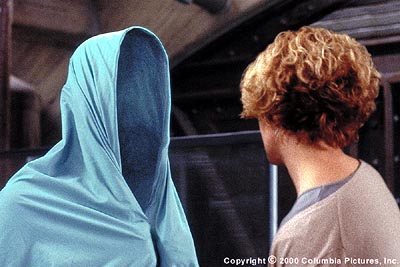“And what does Hollow Man give us apart from a gripping genre exercise? Moviegoing as leering and chortling over crushed mice.” Jonathan Rosenbaum
I just saw Paul Verhoeven’s “Hollow Man”. On first glance (not glance?) it works more or less the way Jonathan Rosembaum says. Scientist Sebastian Caine (Kevin Bacon) figures out a way to make himself invisible, and then uses said invisibility to realize his sadistic rape fantasies while the viewer simultaneously enjoys said fantasies and wags his (presumably) finger at them. The emblematic moment here is the scene (cut from the theatrical release, but restored on DVD) where Rhona Mitra acts out being raped while the viewer fills in the invisible Sebastian. Shot POV, it’s movie-viewer-as-rapist analogy couldn’t be much clearer. Mitra thrashes and shrieks for nobody but the camera. With the rapist transparent, the point of the exercise becomes all too visible. It’s not Sebastian, but the director who is raping her for our elucidation and enjoyment. When the camera lingers on her confused whimpering form following the rape, the answer to her unstated question, Who? is obviously supposed to be “Us.”
So “Hollow Man” is all about implicating the viewer, as the-lack-that-is-not-there provides the excuse for stripping Elizabeth Shue, playing with Kim Dickens’ nipple, and bloodily killing a mouse, a dog, and assorted humans. The Hollow Man is the absent body hollowed out of everything except desire; the full-body-castrati who has exchanged the penis for the phallus/power. The “phase shift” the scientists all gobbledygook about is not just a transformation from seen to un; it’s a move across the plane of the screen — a transformation from movie actor to movie watcher.
All of which is to say that the metaphor is clever. Unfortunately, clever only takes you so far. “Hollow Man” is willing to show the transparent voyeurism of its pulp narrative — but it never actually questions that narrative itself. As a result, all the “implicating the viewer” seems more like hand-waving than actual moral commitment — just a way for Verhoeven and his viewers to have their genre cake while feeling smugly self-aware of it.
The main problem is that, while the movie’s visuals and set pieces raise questions about viewer investment, the narrative itself is much more conventional. In particular, Sebastian is a really predictable power-crazed mad scientist. Even before his transformation, he’s an egocentric leering bastard who refers to himself as God and leches after his neighbor and his ex. Turning invisible doesn’t change him so much as it allows him to release his inner megalomaniac. His final shift to unstoppable insane slasher villain is unbelievable only because unstoppable insane slasher villains aren’t believable. There’s nothing in his character that would make you doubt it.
The point here is that while viewers may occasionally have a stake in Sebastian’s voyeurism, they never have a stake in Sebastian himself. Rape fantasies are not actually rape. One of the differences is that lots of people have rape fantasies while only rapists commit rape. That’s certainly what we tell ourselves, anyway, and “Hollow Man” is happy to go along, providing lots of entertaining voyeurism for the fans while gruesomely punishing the creepy rapist who, we are assured, has no redeeming qualities whatsoever. Jonathan Rosenbaum thinks the film dings the viewer for “leering and chortling” — but he rather passes over the fact that the most cathartic violence in the film is directed not against mice, but against Sebastian himself, who is lit on fire as Elizabeth Shue triumphantly tells him he’s not God.
In contrast, consider something like John Carpenter’s “Christine.” In that film, we initially pity and identify with Arnie Cunningham, the nerdy protagonist. Because we like Arnie, we want him to succeed — to get his act together, get the girl, and get revenge on his enemies. True to our wishes, the film supplies him with all he wants, with the caveat that he simultaneously turns into a monster. Our narrative investment and desires make Arnie what he is, which raises questions about what our narrative investments and desires make of us.
There are other films that work this way too — Cronenberg’s “The Fly,” for example, where the likable Jeff Goldblum becomes a subhuman insect. But “The Hollow Man” takes a much easier route. Sebastian is never the vulnerable kid or quirky nerdy scientist whose striving is our striving; we never see him as weak and hope for him to get strong. He’s always already the evil daddy-thing; the smug sadistic overlord we want to destroy. And destroying him is just what we get to do, cheering Elizabeth Shue on as she outsmarts and then satisfyingly slaughters him. His death is a straightforward triumph, untrammeled by any considerations of his possible humanity. In Hollow Man, when you look at the bad guy, you don’t see yourself.

